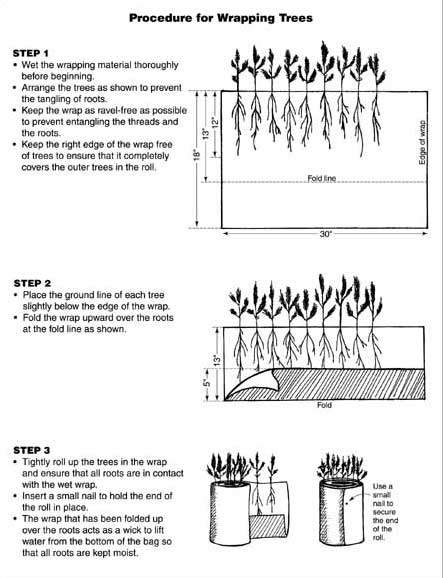 |
 |
Technology & Development Center |
| June 2005 | 2400 | 0524–2323-MTDC |
Brian Vachowski, Project Leader
Traditionally, sheets of burlap have been used for wrapping bareroot seedlings into a bundle or “jelly-roll” as they are taken from cold storage and repackaged to fit into tree planters' bags. Depending on their size, 35 to 50 seedlings are wrapped into each roll (figure 1). Before wrapping, the burlap is soaked in water so it will remain wet until the seedlings are planted. After use, the burlap is hand-rinsed, dried, and reused, sometimes for several seasons.

Figure 1—Diagram for wrapping tree seedlings adapted
from the Silvicultural
Practices Handbook (Forest Service Handbook 2409.17).
The Forest Service, United States Department of Agriculture (USDA), has developed this information for the guidance of its employees, its contractors, and its cooperating Federal and State agencies, and is not responsible for the interpretation or use of this information by anyone except its own employees. The use of trade, firm, or corporation names in this document is for the information and convenience of the reader, and does not constitute an endorsement by the Department of any product or service to the exclusion of others that may be suitable. The U.S. Department of Agriculture (USDA) prohibits discrimination in all its programs and activities on the basis of race, color, national origin, age, disability, and where applicable, sex, marital status, familial status, parental status, religion, sexual orientation, genetic information, political beliefs, reprisal, or because all or part of an individual’s income is derived from any public assistance program. (Not all prohibited bases apply to all programs.) Persons with disabilities who require alternative means for communication of program information (Braille, large print, audiotape, etc.) should contact USDA’s TARGET Center at (202) 720-2600 (voice and TDD). To file a complaint of discrimination, write to USDA, Director, Office of Civil Rights, 1400 Independence Avenue, S.W., Washington, D.C. 20250-9410, or call (800) 795-3272 (voice) or (202) 720-6382 (TDD). USDA is an equal opportunity provider and employer.
|
| Continue |